Mushrooms
Media
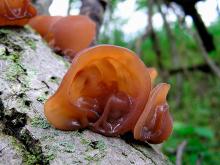
Species Types
Scientific Name
Auricularia auricula (formerly A. auricula-judae)
Description
The wood ear is a reddish brown to grayish black, rubbery, earlike or cup-shaped mushroom. It usually grows in groups on rotting wood.
Media

Species Types
Scientific Name
Morchella angusticeps (formerly M. elata)
Description
The black morel is a prized edible mushroom. It has a honeycombed cap with black to brownish black ridges and yellowish brown pits. It is completely hollow and grows in the spring.
Media

Species Types
Scientific Name
Coprinellus micaceus (formerly Coprinus micaceus)
Description
The mica cap has a bell-shaped, tawny brown, radially lined cap and inky gills. It grows in clusters around stumps or on wood debris.
Media

Species Types
Scientific Name
Pleurotus ostreatus and P. pulmonarius
Description
Oyster mushrooms are choice edibles with broad, fleshy, whitish, grayish, or tan caps and a stubby, off-center stalk. They grow clustered on stumps, logs, and trunks.
Media

Species Types
Scientific Name
Ganoderma sessile (formerly G. lucidum)
Description
The ling chih is a hard, usually flat, zoned bracket fungus with a reddish brown, shiny top. It grows at the base of living and dead deciduous trees, and also around stumps.
Media
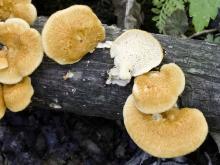
Species Types
Scientific Name
Polyporus alveolaris (formerly Favolus alveolaris)
Description
This polypore is an orange to tan, fan-shaped bracket that is scaly on top; the underside has rows of white, six-sided, radially arranged pores. It grows singly or in groups on dead branches of deciduous trees.
Media
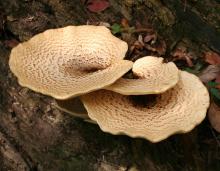
Species Types
Scientific Name
Polyporus squamosus
Description
The dryad's saddle is a large, fleshy, scaly, yellowish tan bracket fungus with large, yellowish white pores and a short stalk; it smells like watermelon rind. It grows singly or in layers, on living or dead deciduous wood.
Media
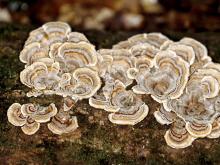
Species Types
Scientific Name
Trametes versicolor
Description
Turkey tail grows in clusters of leathery, thin brackets with multicolored zones above and whitish yellow pores below. Look for it on stumps and logs of deciduous trees.
Media
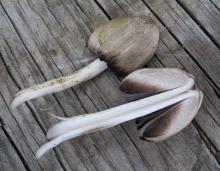
Species Types
Scientific Name
Coprinopsis atramentaria (formerly Coprinus atramentarius)
Description
The alcohol inky has a gray-brown, bell-shaped, radially lined cap and inky gills. It grows in clusters on the ground, usually near rotting or buried wood.
Media

Species Types
Scientific Name
Laccaria laccata
Description
The common laccaria has a small, brownish pink cap with a central depression; the gills and stalk are a pale pinkish brown. Grows scattered or in groups in poor or sandy soil in mixed woods.
See Also



Media

Species Types
Scientific Name
Monotropa hypopitys
Description
Pinesap is a plant that puts the "wild" in wildflower! It lacks chlorophyll, so its roots connect to fungi underground and absorb nutrients from the fungi.
Media

Species Types
Scientific Name
Cladophora, Pithophora, and Spirogyra spp., and others
Description
Filamentous green algae forms green, cottony masses that are free-floating or attached to rocks, debris, or other plants.
Media

Species Types
Scientific Name
Monotropa uniflora
Description
Indian pipe lacks chlorophyll, so it is white, not green. Below ground, its roots join with fungi that connect to tree roots. This plant, then, takes nourishment indirectly from the trees.
About Mushrooms in Missouri
Mushrooms are a lot like plants, but they lack chlorophyll and have to take nutrients from other materials. Mushrooms are neither plants nor animals. They are in a different kingdom — the fungi. Fungi include the familiar mushroom-forming species, plus the yeasts, molds, smuts, and rusts.
Always be cautious when eating edible mushrooms. Be absolutely sure of the ID, and only eat a small amount the first time you try it to avoid a reaction..





















